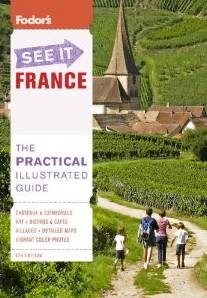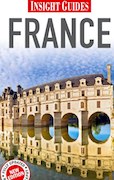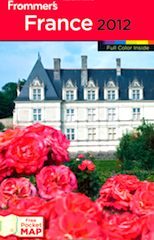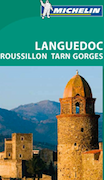Millau Viaduc: World’s Highest, Longest Cable Span Bridge

- SUBSCRIBE
- ALREADY SUBSCRIBED?
BECOME A BONJOUR PARIS MEMBER
Gain full access to our collection of over 5,000 articles and bring the City of Light into your life. Just 60 USD per year.
Find out why you should become a member here.
Sign in
Fill in your credentials below.
 Nature sculpted the beautiful Massif Central coursing the heartland of France, but man created one of its majestic sites.
Nature sculpted the beautiful Massif Central coursing the heartland of France, but man created one of its majestic sites.
Though many regions lay claim as “La France Profonde,” it is a description which most truly fits some of the country’s less-populated departments: Limousin, Correze, Cantal, Auvergne and the northern reaches of Languedoc-Roussillon. This is the land of volcanoes, hard rock and solid-built people who shepherd their flocks on hilly terrains, pasture their cows on windswept plateaus, ripen their cheese in traditional ways and drive their tractors to medieval towns built of stone.
Such areas have not gone undiscovered by tourists. Some, such as picture-perfect Salers, are said to be inundated in summer, but in spring one may find a small number of travelers in the north, a few well-kitted fisherman along Tarn, a smattering of camper vehicles on the winding roads and a dearth of facilities revved up for the season. It’s a perfect time to visit as long as the driver keeps alert for indications that snow is out of the mountain passes.
The views can be as soothing as they are breathtaking—across the volcanic regions to Salers, up hill and down into valleys to Le Puy en Velay and tracking the limestone cliffs and clear waters of the Tarn to its Gorge terminus just ahead of Millau.
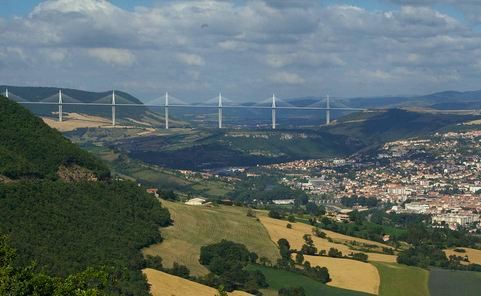 Until this bridge was built, the road through Millau to points north was a summertime nightmare of traffic for Parisiennes rushing home from the south. Then the bridge opened. The man-made beauty of the Viaduct de Millau subsumes even nature’s best efforts.
Until this bridge was built, the road through Millau to points north was a summertime nightmare of traffic for Parisiennes rushing home from the south. Then the bridge opened. The man-made beauty of the Viaduct de Millau subsumes even nature’s best efforts.
This is not just any bridge, it is one of the wonders of the modern world—a steel and concrete public project that is a work of art, an enhancement to life and a bargain as well. It was built in a mere three years and is a stunning accomplishment of artistic, engineering and business brilliance.
One would have to be without soul to see crossing it as just a time-saving, smooth ride, for this is a bridge with which to spend time.
Nothing prepares one for what is to come.
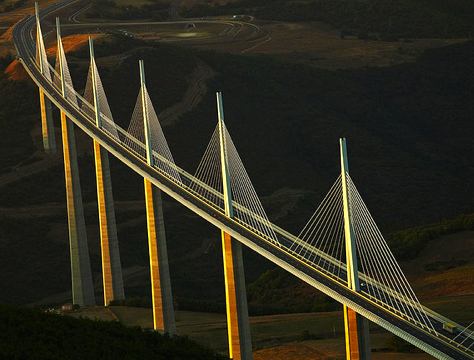
At a distance the viaduct seems a simple span across a valley. On approach from Millau, white cables strung in sail like formation float in the sky. When the seven white piers come into full view, their soaring height accents the depth of the valley in which the River Tarn seems but a stream. The piers, fluted like a fine piece of Chippendale furniture, rise as much as 245 meters (803 feet) to a point pierced like a needle. Seen full-on from the valley, the viaduct becomes a mesmerizing sight which only gets better.
The statistics are staggering: 2,460 meters (8,069 feet) in length with a span of 342 meters (1,122 feet). Piers and abutments consumed 205,000 metric tons (225,000 US tons) of concrete. The deck alone weighs 36,000 metric tons (39,683 US) and was slid into place centimeter by centimeter by means of specially designed equipment.
This and much more information including an interesting short film is well covered at information centers which bracket the bridge and provide some of its best viewing sites.
 Aficionados then travel a few kilometers east for the ultimate view from the small hillside Peyre. So besieged by tourists have residents become that they have created a parking lot below and 200 meters beyond the town and pedestrianized the route to the view.
Aficionados then travel a few kilometers east for the ultimate view from the small hillside Peyre. So besieged by tourists have residents become that they have created a parking lot below and 200 meters beyond the town and pedestrianized the route to the view.
The least interesting view of the bridge may be that for which one pays. Only the vehicle’s passenger gets to enjoy the full visual impact of the graceful span. We paid 6.10 euros for a car crossing which takes but seven or eight minutes.
Perhaps the bridge at Millau will outlast its 120-year structural guarantee just as Gustave Eiffel’s 1880s iron-trussed span of the Truyère at Garabit near St. Flour has done. That bridge 120 kilometers north of Millau carried trains over it for longer than many thought possible. The trains don’t run over it anymore, but people still come by foot, bike, motor car and tourist bus to admire it as an artistic and engineering feat of an earlier time.
Both are engineering marvels to savor.
Copyright © 2010 Jean and Peter Richards
PRACTICAL INFORMATION:
PHOTO CREDITS: Photos by writers & courtesy of Midi-Pyrénees Tourism Office
Subscribe for FREE weekly newsletters with subscriber-only content.
BonjourParis has been a leading France travel and French lifestyle site since 1995.
Readers’ Favorites: Top 100 Books, imports & more at our Amazon store
We daily update our selections, including the newest available with an Amazon.com pre-release discount of 30% or more. Find them by starting here at the back of the Travel section, then work backwards page by page in sections that interest you.
Click on this banner to link to Amazon.com & your purchases support our site….merci!
